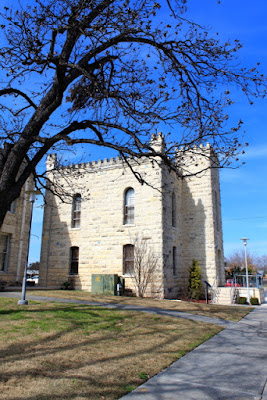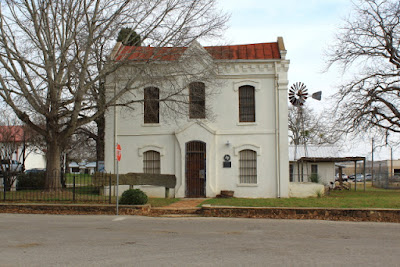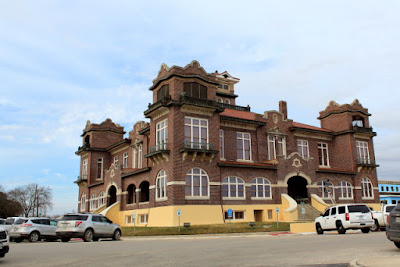Schlitterbahn, named America's No. 1 water park by the Travel Channel, was directly across the street from where we were staying in New Braunfels (Texas). Unfortunately, the water park was closed for the winter months.
New Braunfels, located along the Comal River, was founded in 1845 by German settlers led by Prince Carl of Solms-Braunfels, Commissioner General of the Adelsverein. In December 1844, Christmas Eve services were held under an open sky and Prince Carl provided the first Christmas tree in Texas by having candles placed on a native Texas Oak Tree.
As more German immigrants arrived in the area, by 1850 New Braunfels was the fourth-largest city in Texas. The city still has a strong German influence with many German restaurants and shops. Each year in early November the City hosts the "Best of the Wurst Festival," which includes traditional German bands, dancers, exhibits, and, of course, German sausages. The city is famous for its sausages and breads.
On various occasions we wandered around the historic downtown district to visit some of the many murals, statues, buildings, shops, and the courthouse.
Old Engine No., 7 looked like it was about ready to leave the depot on its daily run.
Of particular interest was the historic Henne Hardware store, which was similar to hardware stores from my early years. I always remember that back in that day you bought nails by the pound - not the box!
And, located along Interstate-35 is Buc-ee's, the world's largest convenience store. Buc-ee's was founded by Arch "Beaver" Aplin, so there is a bronze beaver in front of the store. At 67,000 square feet of retail space, 22 average sized 7-Eleven stores would fit inside of Buc-ee's.
The Buc-ee's complex is located on 18 acres of land, has 83 restroom stalls (Recognized as having the World's Cleanest Restrooms by Cintas business supply company. A full-time attendant is employed just to keep the restrooms clean.), 60 gas pumps, 250 employees, 1,000 parking spaces, 31 cash registers, 80 soda fountain dispensers, gourmet foods, a candy wall, baked goods, a BBQ pit in the middle of the store where they cook and serve pulled pork and barbecue sandwiches, a wide selection of toys, jewelry, household decor, cookbooks, religious items, animal feeders, beachwear, artwork, hunting paraphernalia, and a host of other items.
Gruene, once a small cotton-producing community along the Guadalupe River, is now part of New Braunfels and has shifted its economic production from cotton to tourism.
Germans settled the Gruene area in the mid-1840s and started planting cotton. Soon, more Germans arrived in the area and established a variety of business to support the thriving cotton industry. A cotton gin, powered by water from the Guadalupe River, was built and in 1878 the famous Gruene Hall was constructed. (Gruend Hall is the oldest continually operating dance hall in Texas.) However, in the 1920s the town was decimated by the boil weevil blight and the population fell to about 75 people in the 1930s. In the 1950s highway construction bypassed the community and Gurene became a ghost town.
In 1974, an architecture student at UT Austin discovered the building ruins and received permission from the Texas Historical Commission to inventory the ghost town. About the same time real estate developers purchased 200 acres of land that included the town site and planned to raze the old structures for a new housing project. The student was successful in convincing the developers to save the old buildings and use the town site as the core center for their new housing project.
The town now has a thriving tourist business. New tenants were found for the historic buildings, which include retail shops, restaurants, bed-and-breakfast, art galleries and a winery. The old grist mill, overlooking the Guadalupe River, is now a popular restaurant.
Boerne (population 10,471) was founded in 1849 by a group of German intellectual liberal abolitionists who wanted to create their own version of Thomas Moore's Utopia. Unfortunately, utopia was never reached, but the town is still rich in German heritage and has some of the oldest historic sites in the area. In the 1870s, British army officers played one of the first polo matches in the United States on a site just outside of Boerne.
The town is also famous for the landmark U.S. Supreme Court case City of Boerne v. Flores, when the Catholic Archbishop of San Antonio, Patrick Flores was denied a building permit to enlarge his 1923 mission-style church in the historic district of Boerne. The Archbishop brought suit under the Religious Freedom Restoration Act (RFRA) of 1993. The Fifth Circuit Court agreed with the Archbishop, but the Supreme Court, in an opinion by Justice Anthony Kennedy, found RFRA to be an unconstitutional use of enforcement powers. The supreme court ruling now makes it easier for municipalities to enforce historic preservation ordinances.
The original Kendall County courthouse was construct in 1869-1870 and is the second oldest courthouse in the State of Texas. The courthouse and jail were used until 1998, when a new facility was constructed directly across the street.
Bandera (population 857) was founded in 1855 by Polish families to established a sawmill on the Medina River and was one of the first Polish communities in the United States. There is now substantial ranching in the area and the Texas State Legislature has officially recognized Bandera as the "Cowboy Capital of the World."
The Bandera County Courthouse was constructed in 1890-1891 from plans drawn by Ed Braden & Sons for $5.00. A historic marker indicates that the building style is a "local version of the second renaissance revival. White limestone for the structure was quarried locally."
There are numerous historic stature, monuments, and markers in front of the courthouse.
A historic marker just north of town site marks the location of an abandoned Mormon Colony that was settled in 1854 under the direction of Elder Lyman Wright. It was the first settlement in the area, followed by the Polish settlement on the Medina River.
Cabeza de Vaca from Spain first explored the area around Hondo (population 7,897) in the 1530s, but immigrants from Germany and Belgium were the first settlers in the area in 1881.
In the 1920s the Newton Gang, the most successful outlaws in U.S. History, robbed two banks in Hondo - on the same night!
The famous Hondo sign "This is God's Country, Please Don't Drive Through it Like Hell" was originally erected in the 1930s and has been featured in many magazines, including the cover of National Geographic. The sign was also featured in the music video "God Blessed Texas."
In 1942 the U.S. Army build an airfield just outside of Hondo and at one time it was the largest air navigation school in the world. Before closing in 1946, over 14,000 navigators were trained at the base. The airfield is now used as the South Texas Regional Airport.
The Medina County Courthouse was constructed in 1892-1893 from limestone quarried about six miles north of town.
There is a Stephen F. Austin Memorial Oak Tree that was planted in front of the building on April 15, 2004. The sapling was harvested from a live tree located on the site of Austin's death near present-day West Columbia, Texas. Austin was known as "The Father of Texas" and a tree has been planted in his memory in every county in Texas.
"Old Medina County Jail" was built in 1893 for $15,000. A historic marker on the building indicates that the building is "...designed in the crenellated, round-arch castle style with rock-faced Texas limestone...an image of security often used for jails of that period. The limestone on the Old Jail and Courthouse is from the same quarry just north of Hondo."
Pearsall (population 9,146) was founded in 1880 as a stop on the International-Great Northern Railroad and the town now serves as the primary retail center for a large farming and ranching area. Country and Western Singer George Strait was raised in Pearsall.
Pearsall Presbyterian Church is the oldest church building in continuous use in Pearsall and still has its original pulpit, communion table, and pews.
The House of God church building looked abandoned, so I just opened the door and walked in. Much to my surprise, the building was still in use and the inside of the building was much nicer than I would have anticipated.
Jourdanton (population 3,871) was founded in 1909 as a designated stop on the Artesian Belt Railroad and is the location of the ornate Atascosa County Courthouse that was constructed 1911-1912. A historic marker on the property states: "The two-story brick building has identical entries at each side. Mission revival-style detail includes curvilinear parapets and occasional renaissance motifs, accomplished with cast-stone highlights, metal balustrades, and tile roofing. The corners of the building are turned with three-story tower bays, each topped by an open belvedere."
The area is well-known for production of livestock, oil, gas, and strawberries.
The motto of Pleasanton (population 8,934) is "The City of Live Oaks and Friendly Folks." The town also is known as "The Birthplace of the Cowboy" and has the famous "Mr. Cowboy" sculpture located in front of City Hall. At one time, Willie Nelson was a radio DJ in Pleasanton.
Floresville (population 6,448) was settled by the Spanish who established Christian missions in the area. In the mid 18th century Rancho de las Cabras was established as a ranching operation to support Mission Espada and is considered to be the start of the Texas ranching industry.
Portions of a number of movies have been filmed in Floresville, including "Sugarland Express" (directed by Steven Spielberg), "The Big Brawl" (staring Jackie Chan), "The Great Waldo Pepper" (staring Robert Redford), and "Thaddeus Rose and Eddie" (staring Johnny and June Carter Cash).
The historic Wilson County courthouse and jail are located in downtown Floresville and there is a peanut monument on the front lawn in memory of Joe T. Sheehy (1887-1967) who in 1916 introduced peanut farming to the area. The annual Peanut Festival is held each year on the second weekend in October.






















































